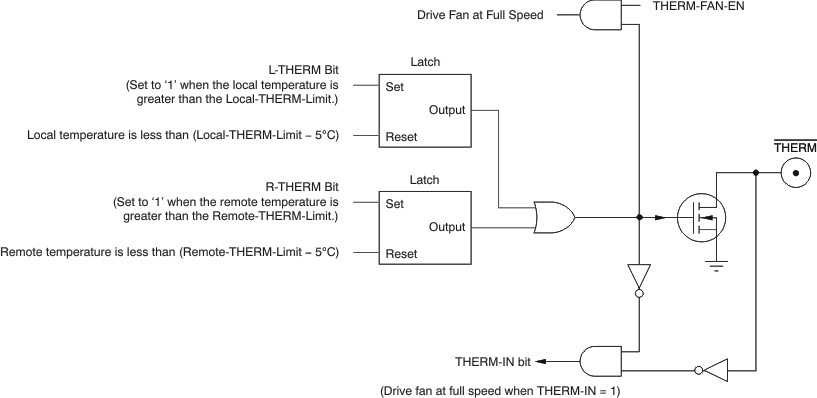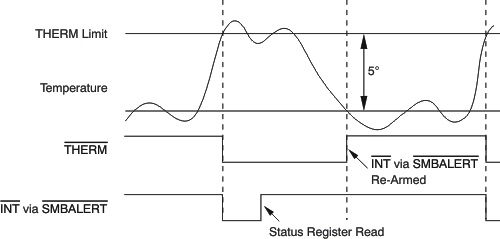JAJSPB8A June 2009 – January 2023 AMC6821-Q1
PRODUCTION DATA
- 1 特長
- 2 アプリケーション
- 3 概要
- 4 Revision History
- 5 概要 (続き)
- 6 Pin Configuration and Functions
- 7 Specifications
-
8 Detailed Description
- 8.1 Functional Block Diagram
- 8.2 Feature Description
- 8.3 Device Functional Modes
- 8.4 Programming
- 8.5 Register Map
- 9 Application and Implementation
- 10Device and Documentation Support
- 11Mechanical, Packaging, and Orderable Information
8.2.8.1.1 THERM Pin as an Output
As an open-drain output, the THERM pin is the indicator of temperature over the THERM limit. When the remote temperature exceeds the Remote-THERM-Limit, or when the local temperature is greater than the Local-THERM-Limit, the THERM pin goes low and remains low until the measured temperature falls 5°C below the exceeded THERM limit.
 Figure 8-12 Structure
of the THERM Pin
Figure 8-12 Structure
of the THERM PinWhen the THERM limit is exceeded, the corresponding status flag bit (R-THERM or L-THERM of Status Register 1 or Status Register 2) is set to '1', and the THERM interrupt through the SMBALERT pin is generated if it is enabled (THERMOVIE of bit Configuration Register 1 is set to '1'). This interrupt forces the SMBALERT pin low. Note that the THERM pin is always forced to low when R-THERM = 1 or L-THERM = 1, no matter what the status of THERMOVIE is. Reading the status registers clears the flag bit (R-THERM and L-THERM). Clearing the flag bit makes the SMBALERT pin go back to high, but does not negate the THERM pin. It remains low until the temperature falls 5�C below the exceeded THERM limit. After this bit is cleared, the active flag bit (R-THERM for remote temperature or L-THERM for local temperature) and the THERM interrupt are not re-armed until the temperature falls 5°C below the exceeded THERM limit. Figure 8-13 shows this procedure.
 Figure 8-13 Operation
of the Therm Interrupt and the THERM Pin
Figure 8-13 Operation
of the Therm Interrupt and the THERM PinWhen working as an output, the status of the THERM pin affects the RPM fan. If the THERM-FAN-EN bit is set ('1'), the fan goes to full-speed (that is, the duty cycle is 100%) when the THERM pin goes low. However, when THERM-FAN-EN = 0, the status of the THERM pin does not affect the fan speed.